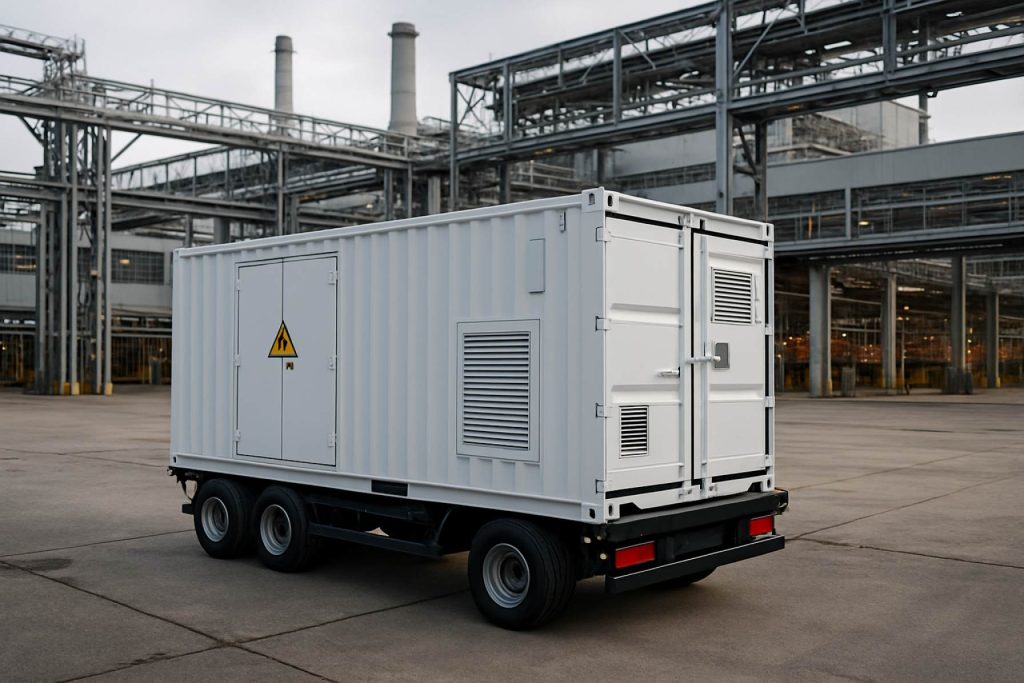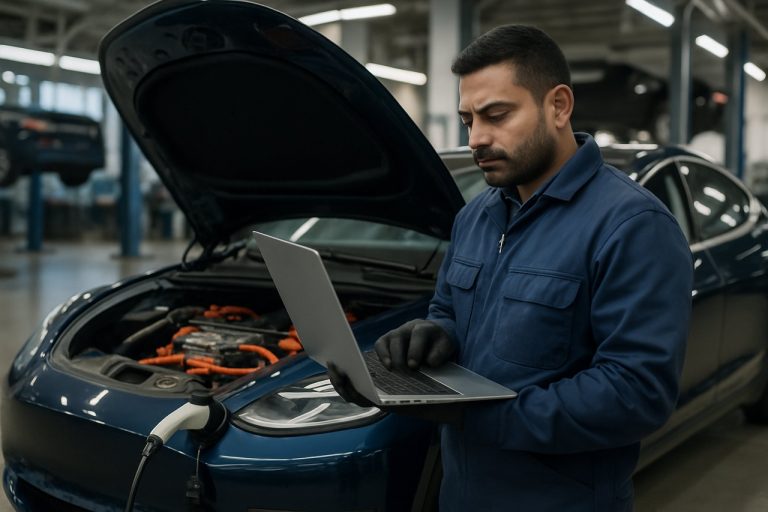
- Repurposed electric vehicle batteries now power Allye Energy’s MegaMAX systems, offering portable and rapid grid backup to prevent blackouts.
- MegaMAX combines up to 18 used battery packs with mixed chemistries, reducing carbon footprint by over 40% and cutting future emissions by 100 metric tons per unit.
- Artificial intelligence enables real-time grid stabilization, providing synthetic inertia and quickly balancing power fluctuations.
- Users benefit from lower electricity costs and can participate in energy markets as both buyers and sellers.
- The mobile, durable design ensures reliable power in emergencies or remote locations, adapting to extreme weather conditions.
- This innovation signals a shift toward smarter, cleaner, and more resilient energy systems for enhanced energy security and climate action.
Steel-gray clouds gathered over European skylines last month, plunging millions into unexpected darkness as blackouts swept across the grid, snapping factories and homes into modern silence. Now, a British technology leap seizes this crisis to promise a future where electricity won’t falter, regardless of the storms that batter our grids.
Outside London, engineers at Allye Energy have shaped discarded electric vehicle batteries—once scattered relics of yesterday’s commutes—into a new force for grid resilience. Their MegaMAX systems stand as armored capsules brimming with silent potential, able to pump out over a megawatt-hour of electricity at a moment’s notice. Imagine a container you can crane off a truck, set down outside a factory, and—within two minutes—ignite enough power to keep a whole production line humming or a hospital’s ICU glowing through the night.
What sets this technology racing ahead isn’t just size or speed, but intelligence. Each MegaMAX box combines up to 18 repurposed battery packs, mixing the chemistry of LFP and NMC cells like a chef blending spices—reducing the system’s embedded carbon footprint by over 40%, and slicing up to 100 metric tons of future carbon emissions per unit. Against the backdrop of urgent climate deadlines, these numbers feel less like statistics and more like lifelines.
Beneath the shell, artificial intelligence runs the show. The platform responds in milliseconds to lurches in grid frequency; where traditional power plants are blunt instruments wobbling to keep up, MegaMAX units anticipate, absorb, and inject synthetic inertia to smooth out instability before humans can even detect the threat. In the jargon of electrical engineering, the “50 Hz hum” that holds Europe’s systems together is now protected by brains as much as by steel.
Even for those unmoved by technical marvels, the implications hit home. Power users can cut electricity costs nearly in half, joining new energy markets as active sellers, not just buyers. When entire regions shudder from transformer fires and the absence of fossil backup, MegaMAX keeps the lights on and life moving.
No less striking is the mobility of the system. At 12 tons, the MAX1000 is built for motion. It rolls off trucks and into action with the efficiency of a modern fire brigade, making it invaluable for emergency response or remote industrial deployments. Its robust enclosure shrugs off dust and rain—from Mediterranean heatwaves to the cold snap of a North Sea winter—earning global attention as a blueprint for rapid, clean grid backup.
As nations scramble to wean themselves from coal, oil, and volatility, MegaMAX points to a world not just powered by technology, but protected by it. The key lesson is clear—batteries are no longer mere toys of consumer gadgets or luxury sedans. In the hands of innovators, they become the battleground—and the shield—for energy security and climate action.
Explore more about energy breakthroughs and sustainable futures at National Geographic or stay current with international developments via BBC News.
Takeaway: As blackouts shed dangerous new light on the fragility of modern power systems, repurposed batteries—guided by cutting-edge AI—are now poised to inject agility, speed, and resilience into the world’s energy mix. The next time darkness threatens, MegaMAX and its kin might be the unseen force holding civilization together.
The Battery Revolution: How Allye Energy’s MegaMAX Will Change Blackouts Forever
The Future of Blackout-Proof Grids: The Untold Details Behind Allye Energy’s MegaMAX Battery Systems
Europe’s recent grid failures have exposed the urgent need for resilient and sustainable energy storage solutions. While the original article highlighted Allye Energy’s impressive MegaMAX technology, there’s much more to unpack for those seeking a deeper understanding and actionable advantages. This in-depth guide expands on the technology’s specs, market impact, real-world applications, limitations, and immediate steps to leverage this disruptive innovation.
—
What Exactly is MegaMAX, and How Does It Work?
The MegaMAX system by Allye Energy is a grid-scale, mobile battery energy storage solution built from recycled EV batteries. Each unit utilizes a hybrid of LFP (Lithium Iron Phosphate) and NMC (Nickel Manganese Cobalt Oxide) chemistries, which balances high power output with safety, endurance, and sustainability.
Key Features & Specs:
– Storage Capacity: Each MAX1000 unit holds over 1.1 MWh of electricity—enough for 1,000+ homes for an hour, or to keep critical hospital equipment running overnight.
– Mobility: Built as a 12-ton containerized unit, MegaMAX can be rapidly deployed and activated in less than 2 minutes.
– Grid Intelligence: Integrated AI and software anticipate and respond to changes in grid frequency (like the crucial 50 Hz in Europe) in milliseconds—faster than human operators or traditional generators.
– Rapid Inertia Response: Provides synthetic inertia, essential for stabilizing grids adapting to renewable energy sources (which lack natural inertia).
– Climate Impact: Cuts embedded carbon emissions by 40% compared to new batteries; avoids up to 100 metric tons of future CO2 emissions per unit.
—
Real-World Use Cases: Who’s Using MegaMAX and How?
1. Emergency Grid Backup: Hospitals, data centers, and critical facilities remain operational during blackouts or severe weather.
2. Industrial Demand Management: Factories shave peak costs by drawing from stored power, while selling excess back when prices spike (“behind-the-meter” optimization).
3. Renewable Integration: Stores excess solar/wind energy and releases it when sunlight or wind drops, preventing both curtailment and outages.
4. Remote Locations & Events: Enables concerts, festivals, and disaster relief operations to run on clean, quiet power without diesel fumes.
5. Microgrids: Islands, military bases, or remote villages combine MegaMAX units with solar/wind to create autonomous energy networks.
—
Market Forecasts & Industry Trends
– Second-Life Batteries: The global market for repurposed EV batteries is projected to surpass $7 billion by 2030 (according to BloombergNEF).
– Grid Investments: European nations and utilities are allocating record amounts to flexible grid solutions, especially post-blackouts and amid fossil phase-outs.
– Regulatory Backing: New EU directives support second-life battery use ([European Commission](https://www.europa.eu)), accelerating project deployment.
—
Reviews & Comparisons: Is MegaMAX Ahead of the Curve?
Pros:
– Lower embodied energy and cost than first-life batteries.
– Ultra-fast grid response, surpassing most diesel or gas backup generators.
– Portable and weatherproof—no need for bespoke building permits or site engineering.
– Monetization opportunities via grid services (e.g., frequency regulation, capacity markets).
Cons/Limitations:
– Battery lifespan depends on prior EV usage; may require more frequent monitoring.
– Not (yet) suitable for ultra-long-duration storage (beyond ~4-6 hours per unit).
– Requires specialized logistics for transport and safe decommissioning at end-of-life.
Major Competitors: Tesla Megapack, Fluence, Samsung SDI—but most rely on new cells rather than second-life EV batteries, which increases their carbon footprint and costs.
—
Security, Sustainability & Regulatory Insights
– Cybersecurity: AI-driven grid systems demand robust protection against digital intrusions; Allye alleges industry-standard encryption and redundant controls.
– Circular Economy: Reusing EV batteries prevents hazardous landfill waste and bridges the recycling gap, contributing to genuine sustainability.
– Compliance: MegaMAX units are certified for international grid codes (including frequency response and fault ride-through standards).
—
FAQs: What Do Readers Need To Know Most?
Q: Are second-life batteries safe?
A: When professionally graded and reassembled, they meet international safety standards; most incidents stem from DIY or unregulated operations.
Q: How expensive are these systems?
A: Significantly cheaper per MWh than new batteries—costs can drop 30-60%, with further savings by minimizing downtime and peak pricing.
Q: Can small businesses or communities access this tech?
A: MegaMAX is scalable: single units can serve small manufacturers; larger clusters power entire districts. Community microgrid initiatives are an emerging trend.
Q: How does it help fight climate change directly?
A: Each MegaMAX unit offsets carbon otherwise emitted by peaker plants, and gives used batteries a second life before recycling.
—
Life Hack: How To Maximize Battery Storage Value
1. Assess your site’s critical load: Know what needs to stay on during an outage.
2. Integrate with renewables: Pair storage with rooftop solar or local wind for full emissions savings.
3. Take part in grid markets: Enroll with your utility or an aggregator to offer “demand response.”
4. Plan for future expansion: Start small with one unit, but design infrastructure so multiple units can be added as needs grow.
—
Actionable Tips & Recommendations
– For Facility Managers: Audit your power needs and identify backup priorities—prepare to request containerized solutions.
– For Policymakers: Prioritize regulations that encourage the use of recycled batteries in grid storage.
– For Investors: Explore fast-growing segments in energy storage that focus on second-life or circular solutions.
– For Communities: Lobby local utilities for resilient, renewable-backed battery microgrids.
—
Final Thought
The blackout-proof future is here—and it’s not just about more wires or wind turbines. It’s about smart storage, rapid deployment, and maximizing every electron’s value—turning old batteries into civilization’s safety net.
For updates on energy innovations and sustainability, visit National Geographic. Stay up-to-date on global energy security news at BBC News.
Don’t wait for the next blackout—explore how grid-scale batteries can power, protect, and profit your world.



